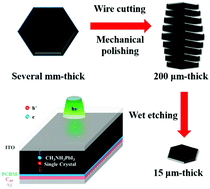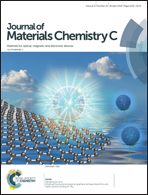A universal top-down approach toward thickness-controllable perovskite single-crystalline thin films†
Abstract
Organic–inorganic hybrid perovskite single crystals have shown superior photophysical properties when compared with their polycrystalline film counterparts. Perovskite single crystal thin films are highly desirable for high-performance optoelectronic devices, but their growth remains a challenge, particularly for perovskite single crystal thin films with controllable thicknesses. Herein, we report a facile top-down strategy to fabricate hybrid perovskite single-crystalline film from its bulk single crystal. The film thickness can be controlled from several millimetres to 15 micrometres. Most importantly, the strategy is feasible for the fabrication of different types of hybrid perovskite single-crystalline films (such as CH3NH3PbI3, CH3NH3PbBr3, and CH3NH3PbCl3) of arbitrary orientations. We demonstrate that vertical-structured photodetectors based on (100)-oriented CH3NH3PbI3 single-crystalline thin films show obvious thickness-dependent photoelectric responses. Such a top-down approach provides a general route to the fabrication of perovskite single-crystalline thin film and may pave the way for the production of a variety of high-performance optoelectronic devices.



 Please wait while we load your content...
Please wait while we load your content...